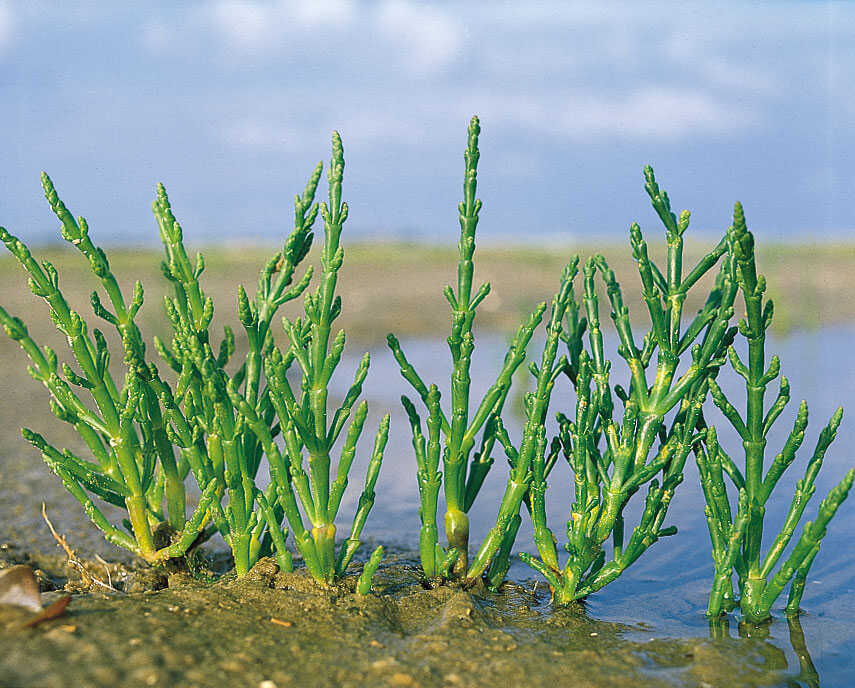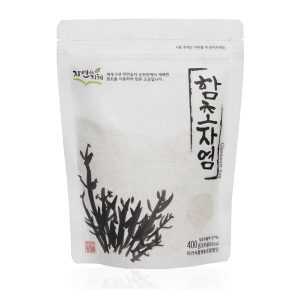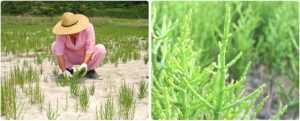
A Salicórnia, também conhecida como sal verde ou sal vegetal, é uma planta que suporta elevadas taxas de salinidade, sendo por isso, classificada como halófita. É bastante utilizada, na Europa, em saladas para substituir a adição de sal, mas também é muito consumida cozida. Tem gosto parecido com o aspargo.
As diversas variedades da salicórnia crescem em salinas costeiras e em outros habitats salgados, como margens de lagos de sal. Também podem crescem parcialmente imersas em água salgada.
Em estudos publicados no Korean Journal for Food Science of Animal Resources, uma equipe de cientistas sul coreanos examinou como utilizar a salicórnia para reduzir a quantidade de sal adicionado em salsichas. A planta é naturalmente salgada, já que cresce nessas águas, e ainda têm um bom teor de fibras, óleos insaturados e proteínas.
A equipe fabricou combinações de salsichas com diferentes proporções de sal e salicórnia em pó. Para que o interior da salsicha seja homogêneo, é preciso extrair proteínas de carne. Algumas dessas proteínas são solúveis na presença de sal, por isso o sal é parte essencial na manutenção da textura da salsicha. Substituí-lo por fontes alternativas é mais complicado do que parece.

As salsichas foram submetidas a uma bateria de testes químicos e físicos para ver como sua textura resistia à presença da salicórnia. Como resultado a planta consegue extrair as proteínas e preservar a textura. Quanto mais salicórnia, mais proteínas eram solubilizadas.
Em outro estudo de 2013, também realizado pelos sul koreanos, foram avaliados os efeitos da aplicação da salicórnia em pó na produção de carne seca do tipo beef jerky. O resultado mostrou-se promissor mostrado que o pó de salicórnia pode ser usado para aprimorar a qualidade sensorial e microbiológica do produto.





continuação: Já chegou a usar a salicórnia? Vi que na Coreia testaram a mesma em salsichas, gostaria de usar na minha produção de linguiça e testar o resultado, será que rola? teria uma dica onde encontrar uma quantidade para esta experiencia? agradeço a atenção e grande abraço
Oi Layrton, infelizmente acho que a salicórnia ainda não evoluiu muito no Brasil desde a publicação deste artigo. Não cheguei a pesquisar, mas também não me deparei com nada a respeito. O que pode tentar é substituir parte do sódio pelo uso do cloreto de potássio e do glutamato monossódico, acredito que seja a forma mais viável atualmente para reduzir a quantidade de sódio. Mas o sódio é realmente algo muito difícil de ser suplantado em sabor e conservação.
Ola Eduardo, como vai? antes de tudo, parabens pelo site Altas dicas, videos tops, realmente aprendendo muito com sua ajuda e as duvidas dos outros, muito obrigado. Estou iniciando os passos na arte de charcutaria, me equipando para fabricar linguiças artesanais(inclusive vou testar sua receitas, ja salvei varias nos meus favoritos do youtube). Por ser hipertenso, comecei pesquisar alternativas para produzir itens com menos sal, mesmo sabendo que ele é um ingrediente fundamental para bom resultado final, alem da conservação das linguiças.Descobri a tal da Salicórnica ou Aspargo do Mar, estou buscando mais informações, mais há pouca coisa disponível sobre ela, creio que no Brasil ainda estamos em fase de testes, alguma produção tímida no sul do país, voce teria mais informações disto?